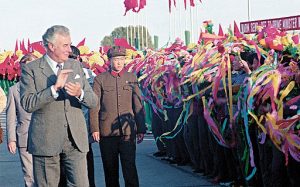
We chose November 11 (Remembrance Day), to launch a new song about the achievements (and setbacks) of Gough Whitlam, our most controversial politician. The 11th marks the 46th anniversary of The Dismissal, when the Queen’s representative, John Kerr, sacked Whitlam and installed a caretaker government under Malcolm Fraser. The dramatic events of 1975 greatly overshadowed the many reforms Gough Whitlam introduced, including free education, free healthcare, no-fault divorce, a single parent’s pension and legal aid. He also ditched conscription and capital punishment and finalised the end of our involvement in the Vietnam War. And, as the photo indicates, he was the first Australian PM to visit China. Many people our age reflect on the Whitlam years as the only time in their adult lives they actually wanted to vote for someone. Unlike most politicians, Whitlam stated clearly what he wanted to do, won the election and then set out to do it all, and then more.
He abolished conscription and capital punishment and made a point of releasing seven men who had been in jail for refusing to go to Vietnam. And, as chronicled in the outstanding song by Paul Kelly and Kev Carmody, he started the process of Aboriginal land rights. Whitlam’s government had the misfortune to be taking the wheel at the time when the economy was going bad; there was inflation and massive unemployment. The global oil crisis did nothing to soothe the people who saw Whitlam as a dangerous maverick. The song includes the downside so is not quite a hagiography, although I did admire the man for allowing me and my peers the chance of a free tertiary education.
Bob Wilson
Have a listen to the song here and if so inclined, add it to your music collection.
‘Well may we say God save the Queen…’
